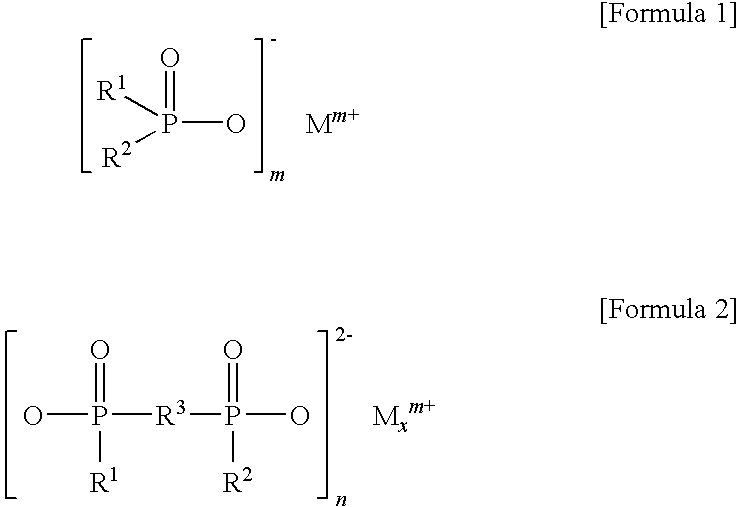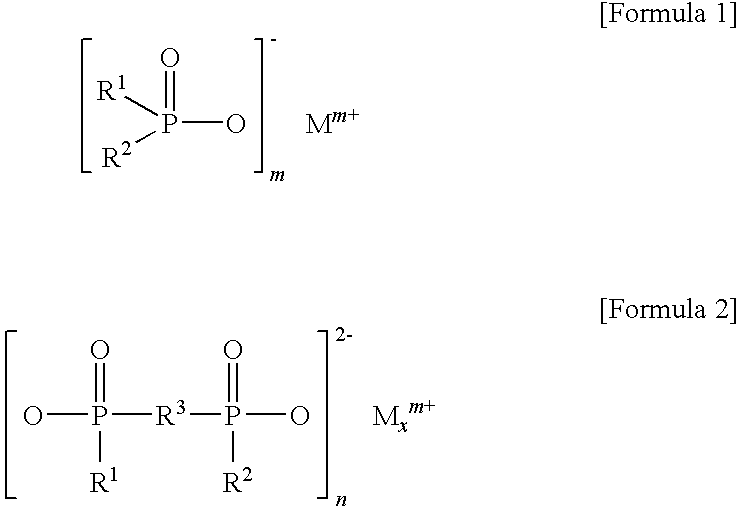Halogen-free flame retardant thermoplastic polyurethanes
a thermoplastic polyurethane and flame retardant technology, applied in the direction of organic chemistry, coatings, group 5/15 element organic compounds, etc., can solve the problems of difficult to apply such a resin using halogen-based flame retardants, restricted use, spread of fire, etc., and achieves improved flaming-drip and high flame retardancy.
- Summary
- Abstract
- Description
- Claims
- Application Information
AI Technical Summary
Benefits of technology
Problems solved by technology
Method used
Image
Examples
preparation example
[0044]A thermoplastic polyurethane resin used in the present invention is a polyether-based thermoplastic polyurethane resin having a shore hardness of 85 A, which is obtained by introducing poly(tetramethylene ether)glycol (a number average molecular weight of 1000), 4,4′-methylenediphenyldiisocyanate, and 1,4butanediol into a continuous reaction extruder (Werner & Pfleiderer ZSK 58 twin screw extruder), and polymerizing the mixture at 190 to 220° C. Herein, the extruder is mounted with a measuring device and has a kneading block whose size ranges 30% based on the total screw area. The thermoplastic polyurethane resin polymerized in the continuous reaction extruder was made into a pellet by a pelletizer, and was dried at 70° C. for 5 hours by using a dehumidifying dryer (Conair SC60, Inlet air dew point=−50° C.). Then, the thermoplastic polyurethane resin was dried at 70° C. for 15 hours, and was used for compounding with a flame retardant (NCO / OH=0.99; MW=250,000).
example 1
[0049]A test sample was prepared by using 60 percent by weight of thermoplastic polyurethane resin, 20 percent by weight of melamine cyanurate, 10 percent by weight of Exolit OP (Clarian), 5 percent by weight of dipentaerythritol, and 5 percent by weight of talc in the same manner as described in Comparative Example 1, and then was sufficiently stabilized. Next, on the sample, physical properties and flame retardancy were measured in accordance with following measuring methods. Table 1 shows the results.
example 2
[0050]A test sample was prepared by using 66 percent by weight of thermoplastic polyurethane resin, 20 percent by weight of melamine cyanurate, 7 percent by weight of Exolit OP (Clarian), 5 percent by weight of dipentaerythritol, and 2 percent by weight of talc in the same manner as described in Comparative Example 1, and then was sufficiently stabilized. Next, on the sample, physical properties and flame retardancy were measured in accordance, with following measuring methods. Table 1 shows the results.
PUM
| Property | Measurement | Unit |
|---|---|---|
| particle size | aaaaa | aaaaa |
| temperature | aaaaa | aaaaa |
| temperature | aaaaa | aaaaa |
Abstract
Description
Claims
Application Information
 Login to View More
Login to View More - R&D
- Intellectual Property
- Life Sciences
- Materials
- Tech Scout
- Unparalleled Data Quality
- Higher Quality Content
- 60% Fewer Hallucinations
Browse by: Latest US Patents, China's latest patents, Technical Efficacy Thesaurus, Application Domain, Technology Topic, Popular Technical Reports.
© 2025 PatSnap. All rights reserved.Legal|Privacy policy|Modern Slavery Act Transparency Statement|Sitemap|About US| Contact US: help@patsnap.com


